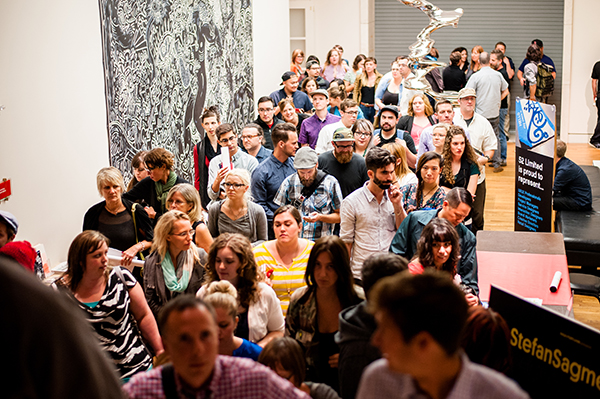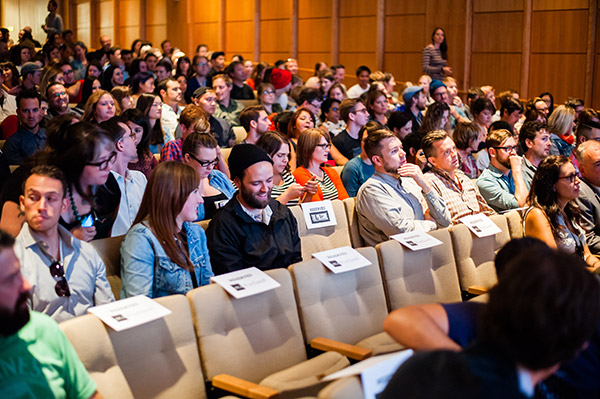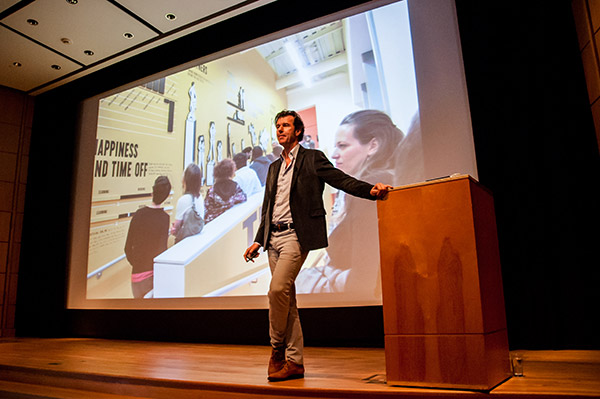A friend and I were recently discussing what the first piece of work we’d ever seen from Stefan Sagmeister was.
After thinking about it for a cool millisecond I responded, “I think it was probably Sagmeister’s AIGA Detroit invitation from the ‘90’s.”
“Mine too!” my friend quickly responded.
“Yeah, I remember thinking that it must have been Photoshopped or digitally retouched,” I continued.
“Me too. I was sure no one would ever carve an entire invitation into their body. Still gives me chills.”
We both agreed that it was genius and moved on to other things.
These are often the types of conversations I imagine people have regarding the Austrian designer’s eclectic and emotionally driven work—not specifically about the AIGA Detroit piece per se, but just how some part of Sagemeister’s work has had an eye opening impact on them and their career.

Lines form at the Stefan Sagmeister speaking event during Design Week Portland. Photo by Pxlvue.
Stefan Sagmeister is perhaps one of the most well known graphic designers working today. His groundbreaking design and penchant for taking risks has helped define modern design practice over the past two decades. His arrival in Portland during Design Week to talk about the subjects of design and happiness were sure to thrill.
I arrived at the venue fairly early–a habit that is both a blessing and a curse. The Whitsell Theatre on the Portland Art Museum campus is a beautiful space filled with blonde wood, stellar acoustics, and a gently sloping auditorium that ensures there’s not a bad seat in the house. All this adds up to a superb place to hold a speaking event.

Stefan’s talk on design and happiness brought in a full crowd to the Whitsell Auditorium. Photo by Pxlvue.
Despite my early arrival, there was already a line of people waiting to get in. A signature speaker like Sagmeister meant that this event was sure to be packed. I found out later that the lecture sold out in a matter of mere minutes making it one of the most anticipated events on the Design Week Portland calendar this year.
”I’ve found that I’m a better consumer of documentaries than maker of documentaries… the discrepancy is the source of a lot of frustration at times.”
Sagmeister took the stage promptly at 6:00PM and immediately launched into a story about his molasses-like approach to documentary filmmaking. His pending film on happiness—a project that came to him during one of his sabbaticals, and that is now 6 years in the making–would set the stage for the entire evening.
The next hour plus revealed Stefan Sagmeister as designer, user-researcher, and social scientist. He took us on a journey encapsulating a near perfect melding of science, data and design. We plummeted into a mountain of research and results about what constitutes happiness from a cognitive and emotional stand point, and the real life implications of a negativity bias. Sagmeister’s insights were seriously hitting all the right spots for myself, and judging from the steady applause, the audience too.
Yet for every fact, figure, and personal anecdote shared, there was an equally continuous stream of visuals–beautiful pieces of work that his firm, Sagmeister & Walsh, have created largely in response to the data being collected for the film. It may have taken his team 6+ years to work on their documentary, but this had not stopped them from prolifically creating and coordinating a series of wonderful stand alone projects, large scale art shows, and beautiful installations drawn from a deep reservoir of inspiration.
While the high points of the evening were numerous, the 400 person sing-a-long to a traditional German folk song and informal “happiness” polling (on a scale of 1 to 5) of the audience were at the top of my list. And yet, my anticipation grew as we moved closer to the impending Q&A. You see, I had waited the entire evening for the answer to one specific question.

Stefan Sagmeister showing some of the work that has come from his studies into happiness. Photo by Pxlvue.
Why, despite his unbelievable success, had Sagmeister intentionally kept his studio at a scant seven people? Why, when you achieve that level of success and opportunity, would you choose to operate in such a lean fashion?
Apparently, I wasn’t the only person who was curious about this. The answer came during the refreshingly honest 20 minute Q&A following his lecture. At the smaller size, Sagmeister & Walsh have more control over their destination—essentially, it allows the studio to pick and choose their projects, rather than saying yes to things simply to cover overhead. A smaller studio means more freedom, more choice.
”Contemporary art is one of the of the few spots in life where something does not need to do anything.”
It was an answer I could have possibly guessed at but hearing it from him made the entire trip worth it. Having stepped out on my own and starting a small studio based in Vancouver, I’ve become extremely interested in the business practices of the evolution of studios and their business practices. Most studios that experience strong periods of popularity seem to grow to meet demand. Sagmeister’s deliberate choice to stay small is an anomaly and one that deserves consideration.
As I left the museum that night and returned to the studio to decompress from a day full of DWP happenings, I was struck by how intentional and deliberate Sagmeister was in his presentation and Q&A. Each statement seemed to be a conscious choice, no doubt the result of the same deep, considerate thinking process employed throughout his career.
View photos from this event.
– – –
 Erin Lynch is a designer, writer, and educator living in Vancouver, WA. He owns the design studio, Shop, and is an editor at The Portland Egotist. Reach out and make friends on Twitter: @erinlynch.
Erin Lynch is a designer, writer, and educator living in Vancouver, WA. He owns the design studio, Shop, and is an editor at The Portland Egotist. Reach out and make friends on Twitter: @erinlynch.